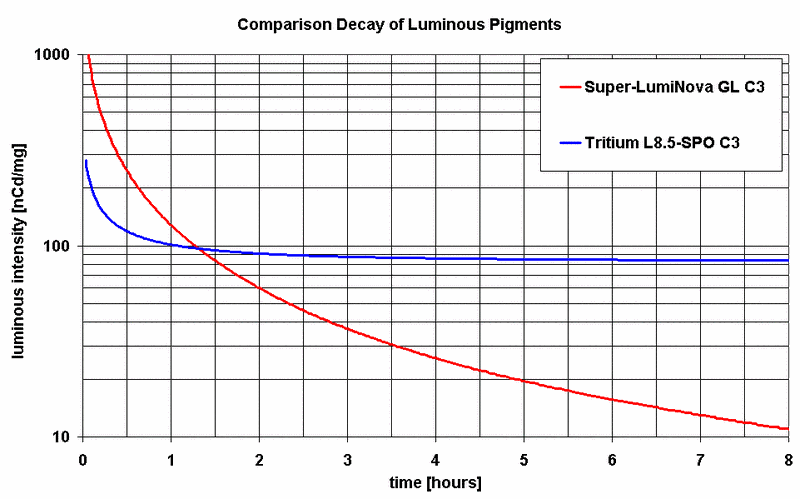I did some research and have provided a culmination of the findings from a number of sources, below are some facts on both Super Luminova and Tritium Tubes:
Super LuminovaBecause it is not a chemical process but a modification of a crystal, Superluminova doesn’t lose its effectiveness over time; GTLS half life is 12.5 years, and it maintains constant brightness throughout its life. Superluminova, however, will never lose its luminous quality, though it does have to be charged by a light source.
Sunlight activated Super-LumiNova initially glows much more brightly than tritium. After about 2 hours, its luminosity declines to the same intensity as tritium. For the next 6 hours, its brightness continues to wane until the value of 7nCd/mm2.
What makes one Superluminova watch’s luminosity better than another? It comes down to the amount of material used and the way it is applied to the watch. None of the watch brands do their own application of Superluminova; it’s all done by small ateliers throughout Switzerland. Companies specify how much, how and where to apply the Superluminova material, and that’s what makes the difference.
“The determining factor is the amount and thickness of Superluminova material, as well as the color, because Superluminova comes in a number of colors, the more material you apply on the dial and the hands, the higher the light storage capacity. Watch brands can use different grain sizes of Superluminova material. For certain designs, the small grains are used to make smooth, shiny surfaces, but they are a little weaker.” - Albert Zeller, managing director of RC Tritec maker of Superluminova
There are a few variables involved in persuading a watch lume to soak up lots of photons:
The dominant wavelength of the illuminating light
The strength (illuminance) of the illumination
The length of time for which the watch is illuminated
Luminous pigments are charged by the UV content of the light, and there is some UV content in most light sources - some more than others. LED UV lamps deliver a good punch, peaking at 365nm or so. Daylight (D65) fluorescent lamps are pretty good, as are the "cool white" or "bright white" variety. Mercury vapor lamps are rich in UV, but sodium lamps are not. The good old-fashioned tungsten lamps have some UV content, but not a lot (sorry, Mr Edison - your time has passed).
Tritium Gas TubesIn watches that use Tritium (officially, gaseous Tritium light source or GTLS), glass tubes holding Tritium gas are placed in the watch under the crystal. “The tubes are made of borosilicate glass, which is temperature resistant,” explains Jakob Bänziger, general manager of MB-Microtec. “The tubes are sent to us in large sections, then we make the tubes smaller and longer. We wash them and apply a coating of phosphorous material inside, then we close them on one end, pump out the air, fill them with Tritium gas, and then we have a light source which is half a meter in length. We then seal off the lengths with a special laser technology that we developed ourselves 25 years ago. We do a lot of testing to make sure they have the right brightness and, more importantly, that the tubes are not leaking."
The level of brightness of the tubes is determined by the pressure of Tritium in the tube, which is determined by the amount of Tritium gas present (from 0 to 2.5 bar of gas). There is, according to Bänziger, no official standard, but MB-Microtec has established a few sizes of GTLSs, and the company can also make custom sizes as long as it is technically possible.
PERFORMANCEAll the watches performed well. The Superluminova watches started out very bright but after a few hours started to lose luminosity. The
Tritium-equipped watches scored the best when it comes to the length of luminosity because they hold the same practical brightness for four to six years, although they didn't always start out as bright as the Superluminova watches. The time listing in the results is the
amount of time it took for the luminescence to dip below the ISO standard for visibility (ISO 3157) . Since Tritium-activated watches maintain brightness for years, the ranking is listed for brightness after three minutes.
SUPERLUMINOVA: TIME PERIOD OF LUMINOSITY•Reactor Flux:12.05 hours
•Tutima DI300: 8.82 hours
•Panerai Luminor Marina: 7.68 hours
•RGM Lancaster: 5.83 hours
•Hamilton Khaki Frogman: 5.42 hours
•Chase-Durer Special Forces 1000: 2.37 hours
SUPERLUMINOVA: BRIGHTNESS AFTER THREE MINUTES•Tutima DI300: 28,223 nCd/watch
•Reactor Flux: 24,060 nCd/watch
•Panerai Luminor Marina: 14,854 nCd/watch
•RGM Lancaster: 8,972 nCd/watch
•Hamilton Khaki Frogman: 7,075 nCd/watch
•Chase-Durer Special Forces 1000: 2,267 nCd/watch
TRITIUM-ACTIVATED: BRIGHTNESS AFTER THREE MINUTES LENGTH CONSTANT: AT LEAST 12.5 YEARS•Ball Engineer Hydrocarbon TMT: 6,504 nCd/watch
•Mondaine SBB Sport Night, white face: 5,717 nCd/watch
•Luminox Model 7001: 3,612 nCd/watch
•Mondaine SBB Sport Night, black face: 3,000 nCd/watch
graph of H3 lume v. Luminova after equivalent charging

The luminosity chosen really depends on what the watch buyer wants and needs. If requiring a watch that is luminous without having to be exposed to a light source, or requiring luminosity over a longer period of time than is possible with Superluminova, the user should consider
a watch that uses the Tritium gas tube technology. It may not glow as brightly as Superluminova at the beginning, but it will maintain a steady state of luminescence. If the watch needs to be visible throughout the night.
References:http://reactorwatch.nl/PR/InSync%20_uminosity_article.pdfhttp://horologyzone.com/watch/watch-school/glow-in-the-dark.htmlhttp://kronometric.org/article/lume/NOTEEdited: Because it is not a chemical process but a modification of a crystal, Superluminova doesn’t lose its effectiveness over time;
it's half life is 12.5 years, and it maintains constant brightness throughout its life.
Corrected to read: Because it is not a chemical process but a modification of a crystal, Superluminova doesn’t lose its effectiveness over time;
GTLS half life is 12.5 years, and it maintains constant brightness throughout its life.












